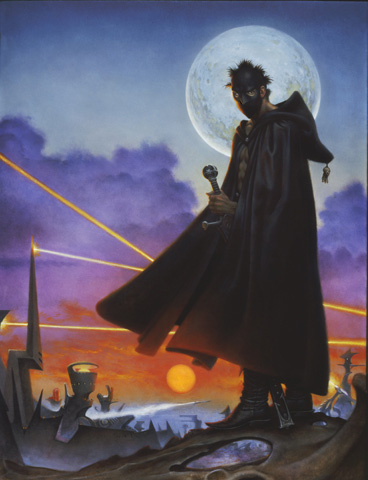For those of you who have followed my book review column for a while now, you probably have a good idea of what my taste in books is. I’m not sure I do, which is why oftentimes I rely on recommendations.
My most recent recommendation was The Book of the New Sun (1980-1983) by Gene Wolfe, a four-part science fantasy thriller set on the dying world of “Urth” and following the grim adventures of Severian, a torturer. In terms of connections with other works I’ve written about in this space, it shares the “Dying Earth” subgenre with a lot of the works of Jack Vance, who I recently penned a feature on. Unlike Vance’s Dying Earth stories, however, Wolfe’s Urth of the red sun serves as a tapestry for a great deal of philosophizing and metaphysicize. In short, it’s a brainy work. It’s also a work that rewards very careful and repeat readings. This review will be broken into two parts—the first a straightforward review meant to prepare prospective readers and the second a commentary for those who have already read Wolfe’s 950-page opus.
If you’re picking up The Book of the New Sun for the first time, there are a few points that might be helpful to know. As a brief aside, the fact that Wolfe can accomplish so much in a 950-page volume that is sensibly broken up into four parts just makes me angrier at Patrick Rothfuss for his overly-cumbersome The Wise Man’s Fear, which you can read my review of here.
The first thing you will notice about Wolfe is his use of language. In short, Wolfe’s prose is very good; it is readable but dense. Like Vance, he is predominantly a stylist, i.e., he is very concerned with the overall effect that the words themselves will convey. Unlike Vance, Wolfe does not make recourse to made-up words except for, perhaps, one instance (that being the alien creature called the “Alzabo”). Otherwise, Wolfe generally substitutes archaic or obscure words in such a way as to communicate out-of-timeliness, otherwordly-ness or anachronism. A clear example of this is in descriptions of soldiers and weapons.
It is made clear through context, for example, that the soldiers of the time period carry energy rifles, yet their weaponry is usually referred to as some form of polearm. He writes that the heavy infantry carries “voulges” (a type of cleaving spear) and of the Ascians that they sometimes “shoved their spears into the ground” and shot themselves with them, as in the fashion of a rifle. He uses the term “peltast,” a Greek light infantryman armed with javelins, to represent light skirmishing soldiers, likely with long-range rifles, and “dimarchi,” a type of horseman used in Alexander’s army, to describe what are in essence dragoons with “lances,” i.e. laser rifles. In describing the dungeon below the Matachin Tower, Wolfe calls it an “oubliette,” an archaic French word for a concealed prison. The general effect of all this wordplay is to introduce a kind of ambiguity in the language of the work, which Wolfe explains by way of an introductory note that this work, written in a language not yet born, is being “translated” for us.
The mysterious and delightfully obscure choice of vocabulary is just the first mystery in The Book of the New Sun.
If the vocabulary is multifaceted and dense in meaning, so too is the story itself. We are introduced straightaway to our first-person narrator, Severian of Nessus, in the first pages of the work. We learn that he has an eidetic memory and that he is writing a memoir of his life (the details of which to follow in the second section). At first, we are taken to trusting Severian because a) he is our window into this unfamiliar world, and b) since he has a “perfect” memory, we instinctually believe that he is truly representing events. We learn as the work goes on that Severian might not be as reliable of a narrator as he, at first, seems.
The world that he inhabits is one of ancient horrors, some native to Urth and some from beyond the stars. There are mysterious structures like the Botanic Gardens that seem to contain scenes from the past, or the towers of the Citadel that may be disused rockets. The other locations in the novel are just as enigmatic: the shrouded House Absolute, the maze-like mountain city of Thrax, the northern mountains containing the fossilized remains of civilizations eons gone. The scope of the work in terms of geography and politics, in short, is massive.
So the prose is masterful and distinct, the narrator and main character is intriguing from the start, and the world itself is dense and interesting. One of the themes that Wolfe brings to the fore is that of Christianity, or to be more specific, Wolfe lets his Christian convictions animate the world of Urth and bleed into its storyline beats. The central object of the story, for example, “the Claw of the Conciliator,” is highly implied to be an artifact of Jesus Christ in some form, and Severian himself is a Christian figure, undergoing a moral transformation.

There are defects with The Book of the New Sun, however. I have said so far that the prose is “dense” and “rewards very careful and repeat readings.” There is another way to look at it. Other readers might find Wolfe’s prose opaque, unnecessarily complicated, and oftentimes confusing. Especially in regard to some of Severian’s discursive philosophical essays, it becomes hard to follow his thread of mental exertion (you might wonder if this is intentional). Severians eidetic memory certainly serves him for recalling detail, but sometimes it is this deluge of detail that (again, I think intentionally) swamps the story and plot elements and renders the actual story somewhat muddled.
I have complained of Rothfuss’s approach to sexuality in his novels, and I would be a hypocrite if I didn’t touch briefly on my opinion that Wolfe is lugubrious here (and I think the erotic discursions are distracting and not really necessary). As I said in my The Wise Man’s Fear review, I may just be a prude and your mileage may vary, but I wasn’t a fan.
Now, for those of you who have read The Book of the New Sun, this last section is for you. Obligatorily: Spoiler alert. You will likely be confused by the end of your first reading. I was confused.
As much as I would love to give a curtesy recap, a real plot summary of the work would be too long, but I recommend Wikipedia’s recap as serviceably thorough.
Still, questions are unanswered. What is the real significance of this Valeria chick? What does the narrator mean when he says there are two Severians? What is Severian’s actual relationship to Dorcas, Owen, etc? What or who really are the Hierodules and how will they judge Severian? How are we supposed to make sense of all the time-travelers like Jonas or the Anchorite?
On the one hand, a lot of these questions are answered in the companion book The Urth of the New Sun (1987), which works to tie up many of the loose ends. On the other hand, I like the ambiguity and openness to reader interpretation that the end of The Book of the New Sun allows. If you’ve just finished the book and want a deeper reading I would recommend heading over to Ultan’s Library, a web resource for people studying and commenting on Wolfe’s fiction. And if you get really hooked, you might pick up a reference work Lexicon Urthus, which serves as a dictionary and companion for The Book of the New Sun.
This is not an exhaustive review, but I hope it was helpful for those considering picking up The Book of the New Sun, or those who would be tempted to pick it up again for a reread. Like the coming of the New Sun, summer is upon us, and having something to read, for bibliophiles like myself, is a must.

